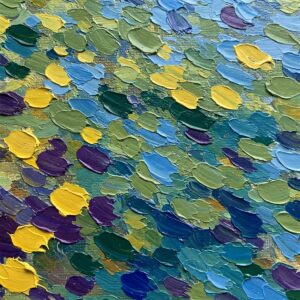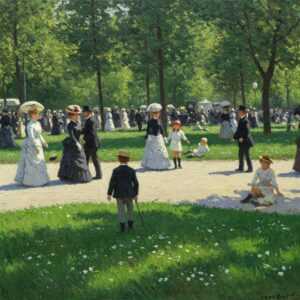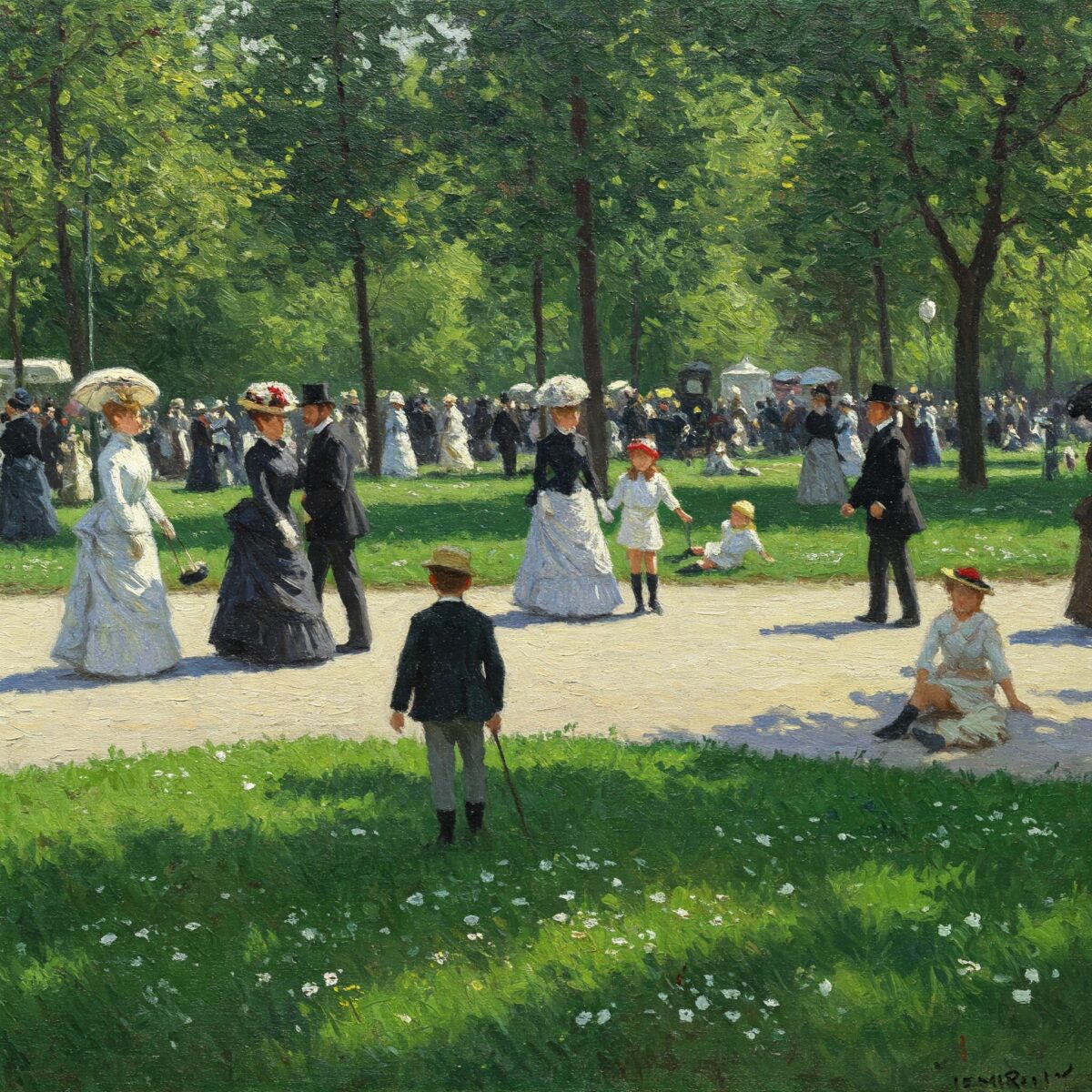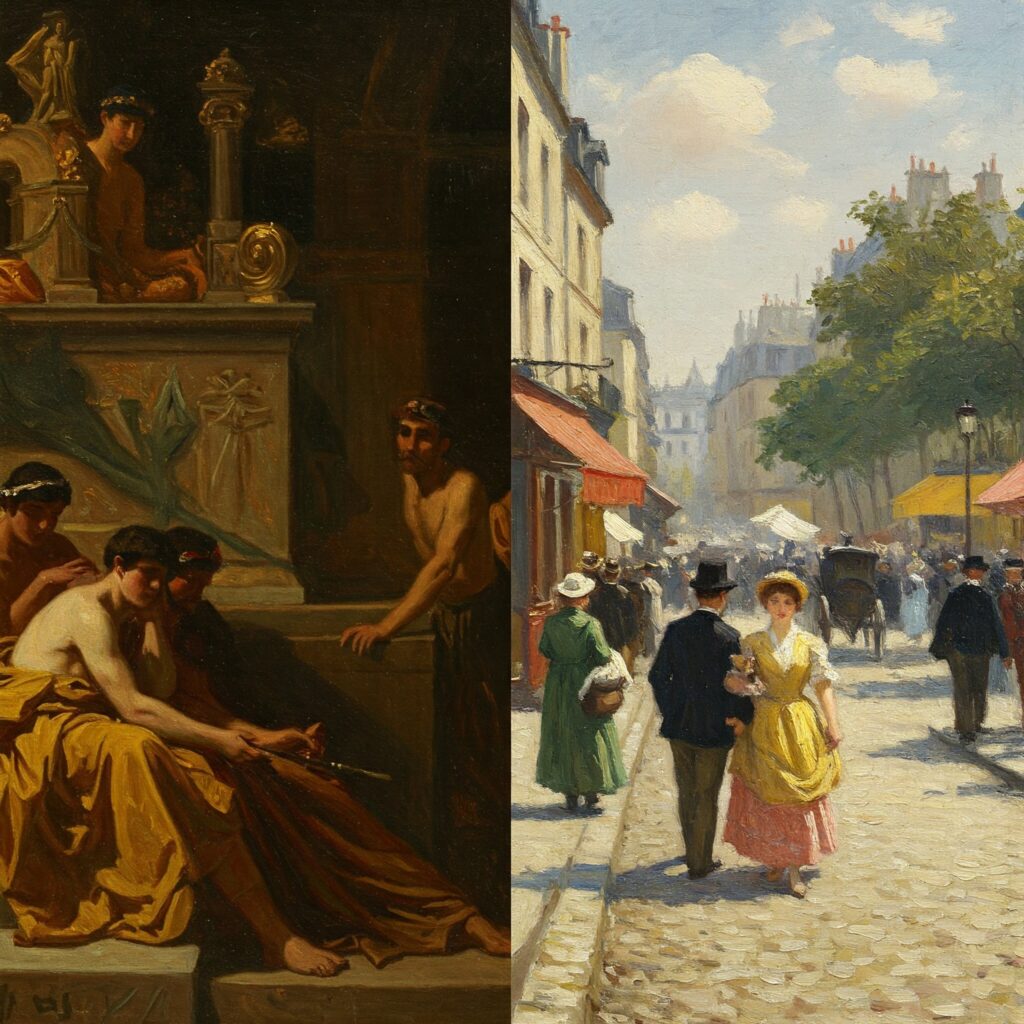
Impressionism is one of the most beloved and influential art movements in history. Born in late 19th-century France, these painters broke all the rules by capturing everyday moments with vibrant colors and visible brushstrokes. So what is Impressionism? Instead of carefully blending paint to create realistic images like artists before them, Impressionists used loose, quick strokes to capture the fleeting effects of light and atmosphere. Their revolutionary approach to painting changed art forever by showing that an “impression” of a scene could be more powerful than a perfect copy of it. The movement got its name from a critic who mockingly described Claude Monet’s painting “Impression, Sunrise” as merely an “impression” rather than a finished work—a criticism that the artists proudly embraced as their identity.
Key Points:
- Impressionism emerged in France during the 1870s and 1880s
- Characterized by visible brushstrokes, bright colors, and focus on light effects
- Emphasized everyday scenes painted outdoors (en plein air)
- Major artists include Claude Monet, Pierre-Auguste Renoir, Edgar Degas, and Berthe Morisot
- Rejected traditional academic painting standards
- Named after Monet’s painting “Impression, Sunrise”
- Paved the way for modern art movements
What is Impressionism and How Did It Begin?
The Impressionist movement began in Paris during the 1870s when a group of independent artists grew frustrated with the rigid rules of the official Paris Salon—the main art exhibition in France. The Salon favored highly polished paintings of historical, mythological, or religious subjects. When these innovative artists were repeatedly rejected from the Salon, they decided to organize their own exhibition in 1874.
The first Impressionist exhibition featured works by Claude Monet, Edgar Degas, Pierre-Auguste Renoir, Camille Pissarro, and Berthe Morisot, among others. A critic viewing Monet’s “Impression, Sunrise” (a hazy view of the harbor at Le Havre) mockingly coined the term “Impressionism,” intending it as an insult. However, the artists embraced the label, and the name stuck.
What began as a rebellion against artistic tradition quickly developed into a vibrant movement that captured the changing nature of modern life in late 19th-century France. Impressionists painted scenes of cafés, theaters, city streets, and countryside leisure activities—subjects that reflected the emerging middle-class lifestyle of the time.
Key Characteristics of Impressionist Painting
Impressionist art has several distinctive features that set it apart from earlier styles:

Light and Atmosphere
Impressionists were obsessed with capturing the effects of light and how it changes throughout the day. They often painted the same scene at different times to show how light transforms colors and shapes. Monet’s series paintings of haystacks, the Rouen Cathedral, and water lilies demonstrate this fascination with changing light conditions.
Visible Brushwork
Unlike academic painters who concealed their brushstrokes, Impressionists used visible, broken brushwork. This technique gives their paintings a lively, vibrant quality and creates a sense of movement.
Outdoor Painting (En Plein Air)
Impressionists took their canvases outdoors to paint directly from nature rather than in studios. This practice of “plein air” painting was revolutionary and allowed them to capture the momentary effects of sunlight and atmosphere. The invention of paint in tubes made this outdoor painting possible.

Everyday Subjects
Rather than grand historical or religious themes, Impressionists painted ordinary life: people relaxing in parks, boating on rivers, strolling on boulevards, or working in fields. This focus on contemporary life marked a significant departure from traditional subject matter.
Color Theory
Impressionists avoided using black for shadows. Instead, they created shadows with complementary colors, following scientific theories about color perception. This approach made their paintings much brighter than earlier works and contributed to their vibrant appearance.
“Everyone discusses my art and pretends to understand, as if it were necessary to understand, when it is simply necessary to love.”
Claude Monet
Impressionism vs. Traditional Academic Painting
This table illustrates the key differences between Impressionism and the traditional academic painting style that dominated before it:
| Aspect | Impressionism | Academic Painting |
|---|---|---|
| Brushwork | Visible, loose strokes | Smooth, invisible brushstrokes |
| Color Use | Bright, vibrant colors with little black | More subdued palette with strong use of dark tones |
| Subject Matter | Everyday scenes, landscapes, modern life | Historical, mythological, religious subjects |
| Painting Location | Primarily outdoors (en plein air) | Studio-based |
| Light Treatment | Focus on capturing changing light effects | Consistent, idealized lighting |
| Composition | Often casual, cropped views | Carefully planned, balanced compositions |
| Detail Level | Suggestion rather than precise rendering | High level of precise detail |
| Purpose | Capturing momentary impressions | Creating timeless, idealized images |
Famous Impressionist Artists
Several key artists defined the Impressionist movement through their distinctive contributions:
Claude Monet (1840-1926)
Often considered the quintessential Impressionist, Monet’s paintings of water lilies, haystacks, and cathedrals showcase his mastery of light effects. His garden at Giverny became both his sanctuary and his most famous subject. Learn more about his works in our article on 10 most famous Claude Monet paintings you need to see.
Pierre-Auguste Renoir (1841-1919)
Renoir specialized in joyful scenes of people enjoying themselves. His paintings often feature warm colors and a sensual approach to the human figure. His influence continues to resonate in art today, as explored in our post on Renoir’s influence on modern art.
Edgar Degas (1834-1917)
Though associated with Impressionism, Degas preferred to call himself a “realist.” He is famous for his paintings of ballet dancers, which combine careful observation with innovative compositions. Unlike most Impressionists, he primarily worked in his studio rather than outdoors.
Berthe Morisot (1841-1895)

One of the few women in the Impressionist circle, Morisot created intimate scenes of domestic life and portraits with loose, feathery brushstrokes. Her work offers a valuable female perspective on 19th-century life.
Mary Cassatt (1844-1926)
An American who lived most of her life in France, Cassatt specialized in depictions of mothers and children. Her work combines Impressionist techniques with influences from Japanese prints.
Camille Pissarro (1830-1903)
Often called the “dean of the Impressionists,” Pissarro was the only artist to exhibit in all eight Impressionist exhibitions. He painted rural landscapes and urban scenes with equal skill.
Alfred Sisley (1839-1899)
Sisley remained dedicated to landscape painting throughout his career. His work, which often features riverscapes and snow scenes, exemplifies the Impressionist approach to nature. Discover more about his work in our article about Alfred Sisley: the quiet master.
Impressionist Techniques
Impressionists developed several innovative techniques to achieve their artistic goals:
Broken Color
Rather than blending colors on the palette, Impressionists placed small, distinct brushstrokes of pure color next to each other. When viewed from a distance, the eye naturally blends these colors, creating a vibrant, shimmering effect known as “optical mixing.”
Quick Execution
To capture fleeting effects of light, Impressionists often worked quickly, completing paintings in a single session or returning at the same time on multiple days to maintain consistent lighting conditions.
Complementary Colors
Following the color theories of scientists like Michel Eugène Chevreul, Impressionists used complementary colors (opposites on the color wheel) to create shadow effects rather than using black. For example, they might use purple for shadows on yellow objects or green for shadows on red surfaces.
For a deeper understanding of these techniques, visit our article on mastering Impressionism light techniques.
Impressionism’s Impact on Modern Life

Impressionism wasn’t just an artistic revolution—it reflected profound changes in society during the late 19th century:
Urban Development
Paris was undergoing massive renovations during this period, creating wide boulevards, parks, and cafés that became subjects for Impressionist painters.
Leisure Activities
The growing middle class had time for leisure activities like boating, picnicking, and attending the theater—all popular subjects in Impressionist works.
Technology
New synthetic pigments gave artists brighter colors, while the invention of photography challenged painters to move beyond mere representation toward capturing sensations and impressions.
The Legacy of Impressionism
Impressionism’s impact on art history cannot be overstated. The movement laid the groundwork for:
Post-Impressionism
Artists like Van Gogh, Cézanne, and Gauguin built upon Impressionist techniques while developing their own distinct styles. Cézanne’s structured approach to nature led toward Cubism, while Van Gogh’s emotional use of color influenced Expressionism. Learn more about how Impressionism influenced modern art movements on our website.
Modern Art
By breaking from academic traditions, Impressionists opened the door for the explosion of experimental art movements in the 20th century, from Fauvism to Abstract Expressionism.
Contemporary Painting
Many contemporary painters still use Impressionist techniques like broken brushwork and careful observation of light. The movement’s emphasis on personal vision and direct experience continues to inspire artists today.
If you’re interested in exploring more about how art movements evolved after Impressionism, check out our comprehensive guide to 20th century art movements.
How to Identify Impressionist Artwork
When looking at a painting, these clues can help you identify Impressionist work:
- Visible, broken brushstrokes
- Bright, vibrant colors with little use of black
- Emphasis on light effects and atmospheric conditions
- Everyday scenes of modern life or natural landscapes
- Lack of sharp outlines or careful details
- Sense of spontaneity and immediacy
For more help identifying different art styles, visit the Metropolitan Museum of Art’s Heilbrunn Timeline of Art History or our own guide to identifying different art movements.
Discover More in our What is …. Series
What is Surrealism? Your Easy Guide to the Art Movement
What is Watercolor Painting? Your First Steps
What is Cubism? A Beginner’s Guide
Conclusion
Impressionism revolutionized how we see and create art by emphasizing personal impression over academic perfection. What started as a radical rejection of tradition has become one of the most beloved and accessible art movements. When we ask “what is Impressionism?” we’re really exploring how these artists taught us to see the world differently—emphasizing light, color, and momentary beauty in everyday scenes. Their legacy lives on not just in museums but in how we appreciate the play of light on water, the vibrancy of a sunset, or the atmosphere of a misty morning. The Impressionists remind us that sometimes the most profound artistic experiences come not from perfectly rendered details but from capturing the essence of a fleeting moment.
FAQ
What are the main characteristics of Impressionism?
Impressionism is characterized by visible brushstrokes, bright colors, emphasis on light and its effects, outdoor painting (en plein air), everyday subject matter, and a sense of spontaneity. Impressionists avoided blending colors completely and instead placed distinct touches of color side by side.
Who were the most important Impressionist artists?
The core Impressionist artists included Claude Monet, Pierre-Auguste Renoir, Edgar Degas, Camille Pissarro, Berthe Morisot, Mary Cassatt, and Alfred Sisley. Édouard Manet, while not technically an Impressionist, was highly influential to the movement.
Why is Claude Monet called the father of Impressionism?
Claude Monet is often called the father of Impressionism because the movement was named after his painting “Impression, Sunrise.” He was also the most consistent in applying Impressionist principles throughout his long career and created iconic series paintings of water lilies, haystacks, and cathedrals that exemplify the movement’s focus on light effects.
How did Impressionism get its name?
Impressionism got its name from Claude Monet’s painting “Impression, Sunrise” (1872). Art critic Louis Leroy used the term mockingly in his review titled “The Exhibition of the Impressionists,” intending it as criticism. However, the artists embraced the name for their movement.
What makes a painting Impressionist?
A painting is considered Impressionist if it uses visible brushstrokes, bright colors, natural light effects, and depicts everyday scenes or landscapes. Impressionist works typically avoid sharp details and black shadows, instead using complementary colors for shadow effects and broken brushwork to create a sense of movement and immediacy.
When did Impressionism start and end?
Impressionism began in the early 1870s in Paris, with the first official Impressionist exhibition held in 1874. The movement continued through the 1880s, with the last Impressionist group exhibition held in 1886. By the 1890s, many Impressionist artists were moving toward new styles that would become known as Post-Impressionism.






